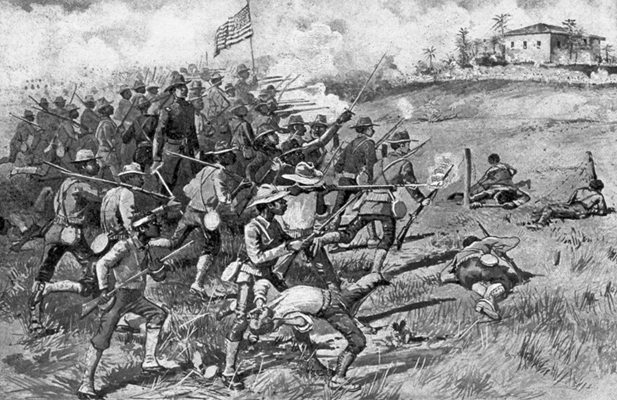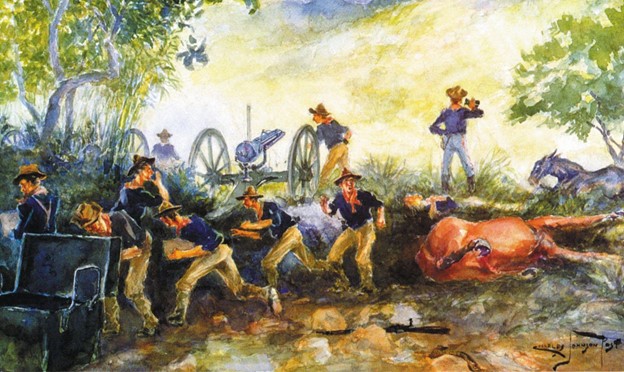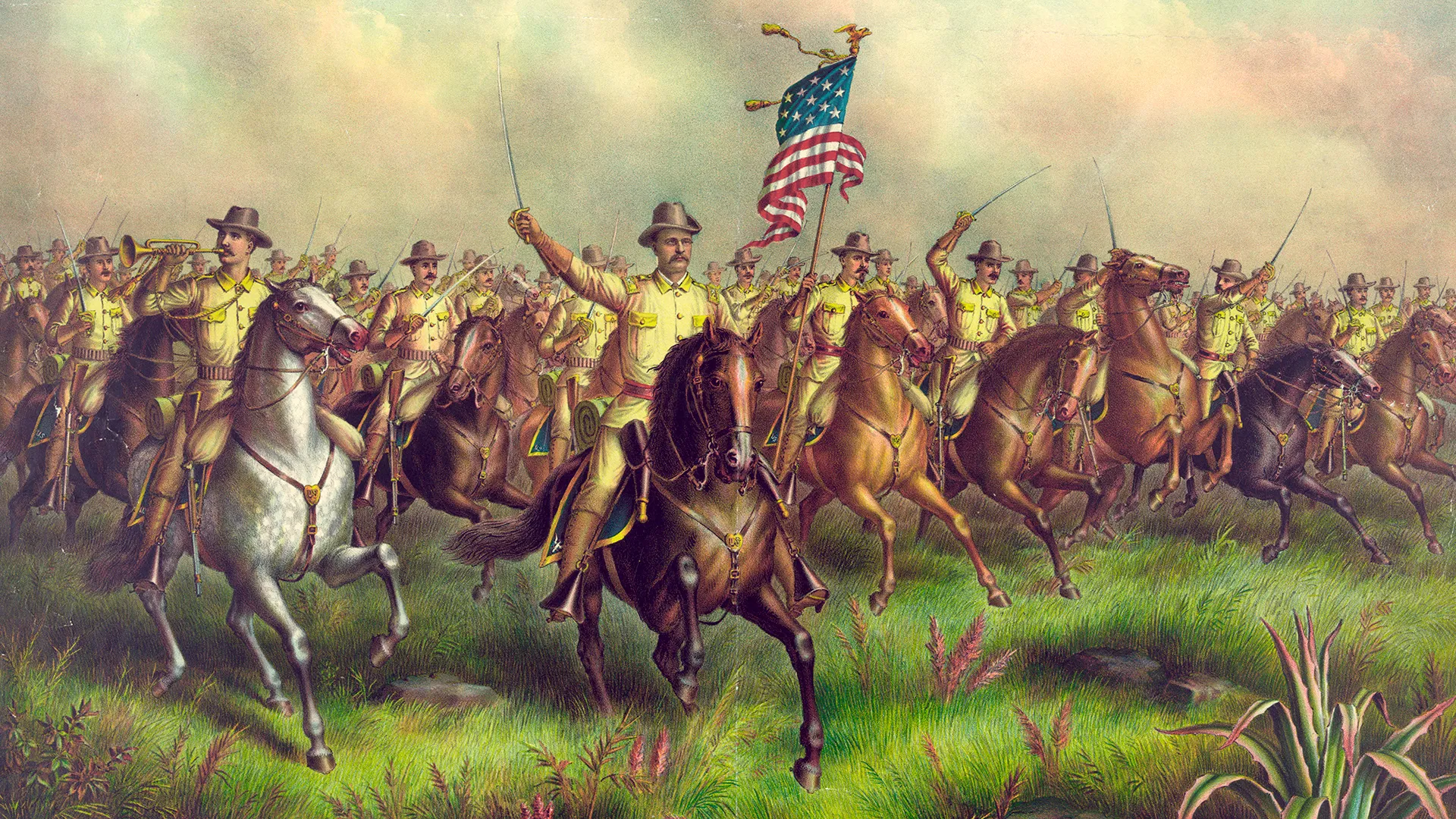When we think of the Spanish-American War’s Battle of San Juan Hill, most of us likely think of future president Theodore Roosevelt and his band of Rough Riders gallantly charging a well-defended Spanish fortification. While that memory of the battle is certainly true, it doesn’t give Roosevelt, the Rough Riders, or the other 8,000 U.S. troops there – including Black troops – the credit they so richly deserve.

San Juan Hill: Where Courage and Unity Led to Victory
The Spanish-American War was declared in April 1898, sparked by the sinking of the USS Maine in Havana harbor due to an explosion that was, at the time, believed to be caused by a Spanish mine (it was later ruled an accident). Spurred on by the sensational American press, the United States blockaded Cuba in retaliation, and Spain declared war in return. Guam had already fallen to U.S. forces, and Americans had already landed in the Philippines by the time U.S. Marines landed at Guantánamo Bay on June 10, 1898.
On June 22, the U.S. Fifth Army Corps landed at Daiquirí and Siboney, east of Santiago, and determined to push toward the city. Some 15,000 American troops, including Roosevelt’s Rough Riders and the Army’s Buffalo Soldiers, were among those who began a march toward Santiago. On July 1, 1898, they crossed the San Juan River, facing a heavily entrenched Spanish enemy atop two hills: San Juan Hill and Kettle Hill.
The United States inflicted a wholesale beating on Spain during the Spanish-American War that was so complete that people tend to forget the stakes of these individual battles. When U.S. troops crossed the San Juan River, they were facing a series of fortified hilltop positions defended by hundreds of Spanish troops, along with another 10,000 reserve soldiers in the city of Santiago de Cuba.

At the outset of the war, Spanish troops in Cuba were largely inexperienced but had very experienced officers who had been fighting insurgents for years. They were carrying new breech-loaded, bolt-action repeating rifles with smokeless cartridges, and Spanish artillery were also more than capable of supporting their infantry.
In contrast, the Americans – who had not fought a major conflict since the Civil War – were using outdated artillery with limited effective range, though U.S. forces were largely carrying Krag rifles with similar capabilities, while Roosevelt had provided his men with lever-action Winchester rifles but the 24th and 25th Colored Infantry (Buffalo Soldiers) were still using single-action black powder rifles.
After crossing the river, the Americans were pinned down by fire from those new, accurate Spanish rifles. As more and more troops crossed the river and waited at the base of San Juan Hill for orders, they became sitting ducks as the Spanish picked them off one by one with rifles as artillery zeroed in.

San Juan Hill: The Turning Point in the Spanish-American War
A Spanish blockhouse dominated San Juan Hill, the higher of the two hills that dominated the San Juan Heights. As casualties began to mount, 1st Lt. Jules Garesche Ord led the 10th Cavalry (Buffalo Soldiers), the 24th (Colored) Infantry Regiment and the 6th, 9th and 13th Infantry Regiments up San Juan Hill, supported by the Army’s first-ever Gatling Gun detachments providing cover fire for their advance. At 150 yards from the crest of the hill, the advance turned into a charge.

At nearby Kettle Hill, Col. Theodore Roosevelt and the 1st Volunteer Cavalry (Rough Riders) launched a near-simultaneous attack on the Spanish positions there. The regulars of the all-Black 9th and 10th Cavalry and the Rough Riders were supported by three Gatling Guns. The Spanish fire was intense before the Gatlings opened on the defenders.
Colonel Roosevelt would receive a posthumous Medal of Honor in 2001 for his daring charge up the hill. In the face of enemy fire, he spurred his men across the open terrain and, accompanied by five men of his own, was the first to reach the Spanish trenches. Roosevelt’s quick action against the enemy trench allowed the assault to continue.

Meanwhile, the Gatling Guns were having a devastating effect. Some 18,000 rounds were fired in less than nine minutes, eviscerating the Spanish and causing them to flee their positions at the top of Kettle Hill. The Black regiments were the first to arrive at its crest, and the rest soon followed, intermingling in their success. A lieutenant in command of the 10th Cavalry at the Battle of San Juan Hill, the future General of the Armies of the United States, John J. Pershing, would later remark:
“…the entire command moved forward as coolly as though the buzzing of bullets was the humming of bees. White regiments, black regiments, regulars, and Rough Riders [i.e., volunteers], representing the young manhood of the North and the South, fought shoulder to shoulder, unmindful of race or color, unmindful of whether commanded by ex-Confederates or not, and mindful of only their common duty as Americans.”
Before 2 p.m. that day, the Americans controlled the heights overlooking Santiago. On July 2, they began the siege of the city. The next day, the U.S. Navy destroyed the Spanish fleet in Cuba. The siege and subsequent capture of Santiago led to a Spanish capitulation on the island, ending 400 years of Spanish rule.
Read About Other Battlefield Chronicles
If you enjoyed learning about the Battle of San Juan Hill, we invite you to read about other battlefield chronicles on our blog. You will also find military book reviews, veterans’ service reflections, famous military units and more on the TogetherWeServed.com blog. If you are a veteran, find your military buddies, view historic boot camp photos, build a printable military service plaque, and more on TogetherWeServed.com today.

I HAVE THIS SAME PHOTO HANGING ON MY WALL IN THE DEN HOWEVER MUCH LARGER.
THIS IS BY RICK REEVES, SANTIGO DE CUBA.
24 JUN 1898/ LOVE IT- IDID (2) TOURS IN CUBA & (3) TOURS IN VIETNAM, also a Silver Star recipient in 1967 operation (Buffalo)
RETIRED MARINE SGTMAJ/USMC